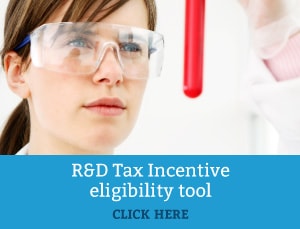CSL Urges R&D Tax Incentive Safeguard
April 26th, 2016 In launching the innovation and science agenda in December, the Australian Government announced that they would be undertaking a review of the R&D Tax Incentive programme. At present, the review is currently ongoing by a panel led by Bill Ferris and it is expected to report to Government in April 2016. However, the announcement of a review has resulted in companies underlining their apprehensions about changes to the initiative. Most recently, CSL has joined industry appeals to the federal government to refrain from altering the popular research and development incentive amid fears it will be reduced.
In launching the innovation and science agenda in December, the Australian Government announced that they would be undertaking a review of the R&D Tax Incentive programme. At present, the review is currently ongoing by a panel led by Bill Ferris and it is expected to report to Government in April 2016. However, the announcement of a review has resulted in companies underlining their apprehensions about changes to the initiative. Most recently, CSL has joined industry appeals to the federal government to refrain from altering the popular research and development incentive amid fears it will be reduced.
Bill Ferris, who is leading the review, has revealed he is considering if the R&D tax incentive could be recalibrated to reward collaboration. Moreover, he noted that Australia was last out of 26 OECD countries that report on collaboration between business and public research institutions on innovation. Ferris further described that in recent decades Australia had been far more successful with research discoveries than it had been in the commercialisation of new products.
Indeed, research and development occurs in universities and in businesses – but there is little connection between the two. Tax concessions are one way to cultivate a partnership between businesses and universities. This would balance government support and mimic successful tax models that are utilised in the United States and United Kingdom. However, as noted in a previous post, the stability of the R&D tax incentive scheme over time plays an important role on R&D expenditure. Thus, the structure of the program should not be altered too drastically.
Likewise, CSL’s chairman John Shine has warned against changing the structure of the program. He notes, “Other countries do provide tax and other incentives to attract hi-tech industry and intellectual property and hi-tech manufacturing… Australia has to be competitive and recognise if a company is going to invest a lot of money in research, which is never guaranteed a success, it does need to be recognised that this is risky and any sort of incentive can help.”
Similarly, medical researcher, Professor Ian Gust, who headed up research and development for CSL for 17 years, said countries that were most successful in R&D had strong government support schemes. Specifically, he warns, “research is now internationally competitive and there’s huge competition between various jurisdictions, any watering down of the incentives in Australia would see Australia put at a tremendous disadvantage.”
Essentially, companies need a stable legislative platform to provide them with the confidence to make long-term decisions in anticipation that support will be available. In fact, Australia’s R&D Tax Cash Benefit Tops OECD Comparison, with Australia topping the globe for loss making entities with the 43.5 per cent cash back benefit. Whilst there may be opportunity to enhance the efficiency of the R&D Tax Incentive in regards to university collaboration; any changes must not adversely impact the fundamental structure of the programme, which provides a broad-based, easily accessed and significant incentive.
If you would like to discuss the R&D Tax Incentive further, please do not hesitate to contact one of Swanson Reed’s offices today.
Categories
- ATO Guidance and Materials
- AusIndustry Guidance and Materials
- Case Law
- Federal Budget 2021
- Federal Budget 2022
- For Accountants
- General Information
- Government Policy and Treasury
- Industry Specific Issues
- Interpretative Decisions
- Legislation and Parliamentary Matters
- R&D Tax Credit
- R&D Tax Funding Strategies
- R&D Tax Loans
- Recent News
- Tax Determinations
Archives
- April 2024
- March 2024
- February 2024
- January 2024
- December 2023
- November 2023
- October 2023
- September 2023
- August 2023
- July 2023
- June 2023
- May 2023
- April 2023
- March 2023
- February 2023
- January 2023
- December 2022
- November 2022
- October 2022
- September 2022
- August 2022
- July 2022
- June 2022
- May 2022
- April 2022
- March 2022
- February 2022
- January 2022
- December 2021
- November 2021
- October 2021
- September 2021
- August 2021
- July 2021
- June 2021
- May 2021
- April 2021
- March 2021
- February 2021
- January 2021
- December 2020
- November 2020
- October 2020
- September 2020
- August 2020
- July 2020
- June 2020
- May 2020
- April 2020
- March 2020
- February 2020
- January 2020
- December 2019
- November 2019
- October 2019
- September 2019
- August 2019
- July 2019
- June 2019
- May 2019
- April 2019
- March 2019
- February 2019
- January 2019
- December 2018
- November 2018
- September 2018
- July 2018
- June 2018
- May 2018
- April 2018
- March 2018
- February 2018
- January 2018
- December 2017
- November 2017
- September 2017
- August 2017
- July 2017
- June 2017
- May 2017
- April 2017
- March 2017
- February 2017
- January 2017
- December 2016
- November 2016
- October 2016
- September 2016
- August 2016
- July 2016
- June 2016
- May 2016
- April 2016
- March 2016
- February 2016
- January 2016
- December 2015
- November 2015
- October 2015
- September 2015
- August 2015
- July 2015
- June 2015
- May 2015
- April 2015
- March 2015
- February 2015
- January 2015
- November 2014
- October 2014
- September 2014
- August 2014
- July 2014
- June 2014
- May 2014
- April 2014
- March 2014
- February 2014
- January 2014
- December 2013
- November 2013
- October 2013
- September 2013
- May 2013
- April 2013
- March 2013
- September 2012
- August 2012
- June 2012


 Free Call: 1300 009 390
Free Call: 1300 009 390





 News & Research
News & Research



